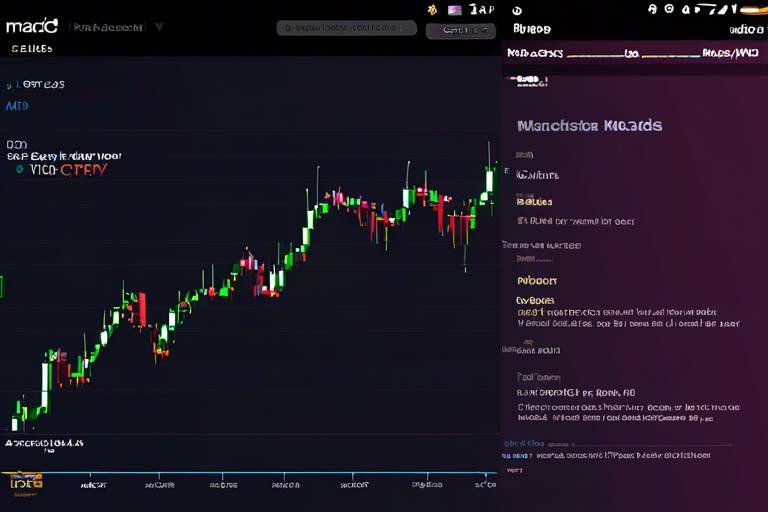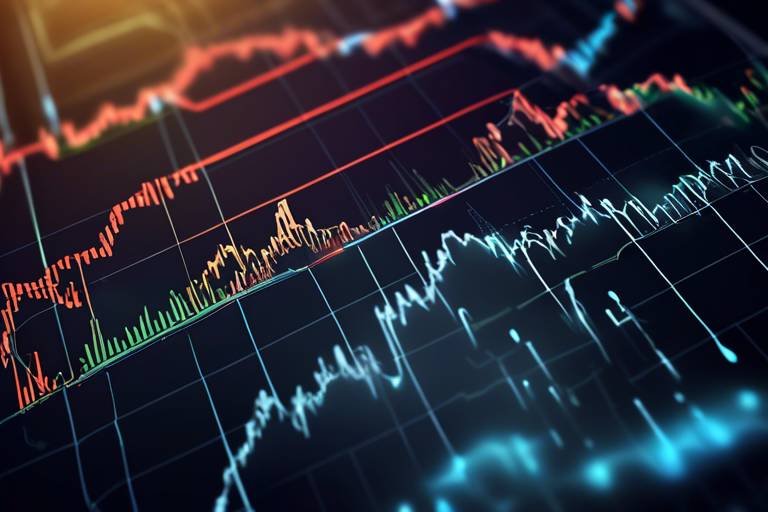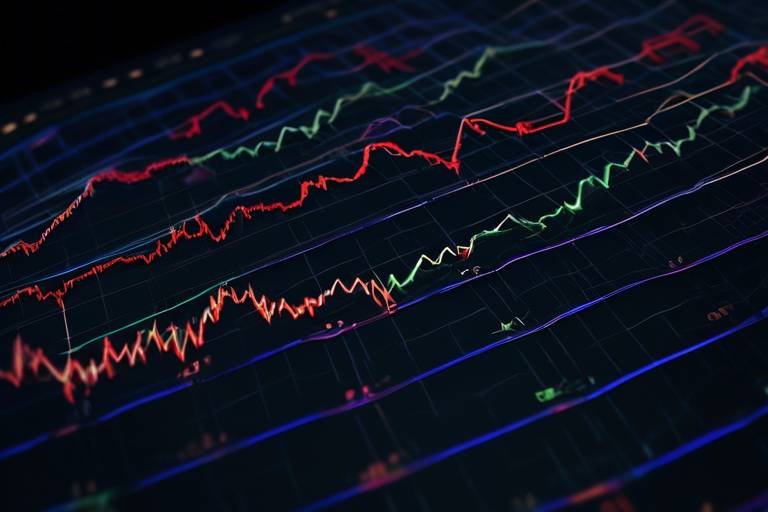Understanding the Importance of Crypto Trading Education
In today's fast-paced digital world, cryptocurrency trading has become a hot topic, drawing in both seasoned investors and curious newcomers alike. But have you ever stopped to think about what truly separates successful traders from those who struggle? The answer often lies in one key factor: education. Just like any other form of investment, understanding the intricacies of the cryptocurrency market is essential for making informed decisions. Without a solid foundation of knowledge, traders can easily fall prey to the volatility and unpredictability that characterize this space.
Imagine trying to navigate a dense forest without a map or compass. You might stumble upon beautiful sights, but chances are, you’ll also get lost or even encounter dangerous paths. The same goes for crypto trading. Without proper education, you're essentially wandering through the market blindfolded. This article will explore the critical role that education plays in successful cryptocurrency trading, highlighting key concepts, strategies, and resources that can help aspiring traders enhance their knowledge and skills.
When it comes to crypto trading, education is not just a luxury; it’s a necessity. The cryptocurrency market operates on principles that differ significantly from traditional financial markets. Understanding how these markets function, the significance of blockchain technology, and the various types of cryptocurrencies available for trading can provide a significant advantage. For instance, did you know there are over 10,000 cryptocurrencies in existence, each with its own unique characteristics and potential for growth? Without the right education, it can be overwhelming to navigate this vast landscape.
Moreover, education in crypto trading equips traders with the tools they need to develop effective strategies. Whether you're interested in day trading, swing trading, or long-term investing, knowing the nuances of each approach can help you align your trading style with your financial goals and risk tolerance. A well-informed trader is more likely to make rational decisions rather than emotional ones, which is crucial in a market known for its wild price swings.
As we delve deeper into the world of cryptocurrency trading, we will touch on various essential topics, including technical and fundamental analysis, risk management techniques, and the importance of emotional discipline. Together, these elements form a comprehensive educational framework that can empower traders to make smarter decisions and ultimately achieve success in the crypto space.
In conclusion, the importance of crypto trading education cannot be overstated. It is the cornerstone upon which successful trading careers are built. So, if you're serious about diving into the world of cryptocurrency, investing time and effort into your education will pay off in the long run. Stay tuned as we explore the various facets of crypto trading, providing you with the knowledge you need to thrive in this exciting yet challenging market.
- Why is education important in cryptocurrency trading? Education helps traders understand market dynamics, develop effective strategies, and make informed decisions, reducing the risk of losses.
- What are the key components of crypto trading education? Key components include understanding market operations, technical and fundamental analysis, risk management, and emotional discipline.
- How can I find reliable educational resources for crypto trading? Look for reputable online courses, books authored by experienced traders, and active community forums where knowledge is shared.

The Basics of Cryptocurrency Trading
Welcome to the thrilling world of cryptocurrency trading! If you’re just dipping your toes into this vast ocean, it’s vital to understand the fundamental concepts that underpin the market. Cryptocurrency trading isn’t just about buying low and selling high; it’s about grasping how markets operate, the revolutionary technology behind these digital assets, and the myriad of cryptocurrencies available for trading.
First things first, let’s talk about how the markets operate. Cryptocurrency markets are decentralized, which means they don’t rely on a single entity, like a bank or government, to manage transactions. Instead, they function on a peer-to-peer network, allowing users to trade directly with one another. This decentralization is facilitated by blockchain technology—a secure and transparent ledger system that records all transactions. Imagine it as a digital notebook that everyone can see, but no one can erase. This transparency builds trust among traders and is a fundamental reason why cryptocurrencies have gained such popularity.
Now, let’s dive into the types of cryptocurrencies you can trade. There are thousands of cryptocurrencies available, each with its unique features and use cases. Here are some of the most notable categories:
- Bitcoin (BTC): The first and most well-known cryptocurrency, often referred to as digital gold.
- Altcoins: Any cryptocurrency other than Bitcoin, including Ethereum (ETH), Ripple (XRP), and Litecoin (LTC).
- Stablecoins: Cryptocurrencies pegged to stable assets, like the US dollar, to minimize volatility. Examples include Tether (USDT) and USD Coin (USDC).
Understanding these categories can help you navigate the trading landscape more effectively. Each type of cryptocurrency has its own market dynamics, so knowing what you’re dealing with is crucial. For instance, while Bitcoin is often seen as a store of value, altcoins can be more volatile and may offer higher risk and reward potential.
Moreover, the significance of blockchain technology cannot be overstated. It’s the backbone of all cryptocurrencies, enabling secure, transparent, and tamper-proof transactions. By understanding how blockchain works, you’ll have a better grasp of what makes each cryptocurrency unique and how they can fit into your trading strategy. Think of blockchain as the foundation of a house; without it, everything else would crumble.
In summary, the basics of cryptocurrency trading revolve around understanding the decentralized nature of the markets, the variety of cryptocurrencies available, and the underlying technology that powers them. As you embark on your trading journey, remember that education is key. The more you know, the better equipped you’ll be to make informed trading decisions. So buckle up, because the world of crypto trading is not just a trend; it’s a revolution!
Q: What is cryptocurrency trading?
A: Cryptocurrency trading involves buying and selling digital currencies on various platforms with the aim of making a profit.
Q: How do I start trading cryptocurrencies?
A: To start trading, you need to choose a reliable exchange, create an account, deposit funds, and then you can begin buying and selling cryptocurrencies.
Q: What are the risks involved in cryptocurrency trading?
A: The crypto market is highly volatile, which means prices can fluctuate dramatically. It’s essential to understand these risks and employ risk management techniques.
Q: Is it necessary to understand blockchain technology to trade cryptocurrencies?
A: While it’s not mandatory, having a basic understanding of blockchain can significantly enhance your trading strategies and decision-making.

Key Trading Strategies
When it comes to trading cryptocurrencies, having a solid strategy can be the difference between success and failure. Just like a chef needs a recipe to create a delicious dish, traders require well-defined strategies to navigate the volatile waters of the crypto market. There are various approaches to trading, each tailored to different financial goals and risk tolerances. Let's dive into some of the most popular strategies that traders can adopt.
First up is day trading. This strategy involves making multiple trades within a single day, capitalizing on short-term price movements. Day traders are like sprinters, quick on their feet and ready to react to market changes in real-time. They often rely on technical analysis and chart patterns to make split-second decisions. However, this approach requires a significant time commitment and a strong understanding of market trends. A day trader must be prepared to monitor their positions closely and be ready to exit trades at a moment's notice.
On the other end of the spectrum, we have swing trading. This strategy is akin to a long-distance runner; it requires patience and a focus on longer-term trends. Swing traders hold onto their positions for several days or weeks, looking to profit from price swings in the market. They analyze both technical and fundamental factors to identify potential entry and exit points. This approach allows traders to capitalize on larger price movements without the need to be glued to their screens all day.
For those who prefer a more laid-back approach, long-term investing might be the way to go. Think of it as planting a tree and watching it grow over time. Long-term investors buy and hold cryptocurrencies with the expectation that their value will increase significantly over the years. This strategy requires a strong belief in the underlying technology and market potential of the chosen cryptocurrencies. While it may not offer the thrill of day trading, it can lead to substantial returns if done correctly.
Now, let's talk about the tools that can enhance these strategies. Many traders utilize technical analysis to inform their decisions. This involves studying price charts and identifying patterns or trends that can indicate future price movements. For example, chart patterns like head and shoulders or triangles can signal potential reversals or continuations in the market. Understanding these patterns can provide traders with a competitive edge.
Moreover, traders often rely on various indicators and tools to assist in their analysis. Popular indicators include moving averages, which help smooth out price data to identify trends, and the Relative Strength Index (RSI), which measures the speed and change of price movements. By incorporating these tools into their strategies, traders can make more informed decisions and reduce the risk of emotional trading.
In summary, whether you're a day trader, swing trader, or long-term investor, understanding these key trading strategies is vital to your success in the cryptocurrency market. Each approach has its unique advantages and challenges, so it's essential to choose one that aligns with your financial goals and risk tolerance. Remember, the world of crypto trading is ever-evolving, and staying educated on the latest strategies and tools will only enhance your trading journey.
- What is the best trading strategy for beginners? Beginners might find swing trading more suitable as it requires less constant monitoring and allows for more extensive analysis.
- How can I manage risks while trading? Implementing stop-loss orders and diversifying your portfolio are effective ways to manage risks.
- Is technical analysis necessary for trading? While not mandatory, technical analysis can provide valuable insights into market trends and help inform trading decisions.

Technical Analysis
Technical analysis is like having a crystal ball in the world of cryptocurrency trading. It allows traders to peek into the future by analyzing past market data, primarily price and volume. By understanding how to read charts and use various indicators, you can make informed predictions about where the market is headed. But what exactly does that entail? Well, let’s break it down!
At its core, technical analysis revolves around the idea that all relevant information about a cryptocurrency is already reflected in its price. This means that by studying price movements and patterns, traders can gain insights into market sentiment and potential future movements. It’s a bit like watching the tides; once you understand the patterns, you can anticipate when the waves will rise or fall.
One of the fundamental tools in technical analysis is chart patterns. These are formations created by the price movements of a cryptocurrency over time. Common patterns include:
- Head and Shoulders: This pattern often indicates a reversal in trend.
- Triangles: These can signify continuation or reversal, depending on the breakout direction.
- Flags and Pennants: These suggest brief consolidation before a continuation of the previous trend.
By recognizing these patterns, traders can position themselves to take advantage of potential price movements. But that’s not all; technical analysis also employs various indicators and tools to make sense of the data.
Indicators like moving averages, Relative Strength Index (RSI), and MACD (Moving Average Convergence Divergence) provide additional layers of insight. For instance, moving averages smooth out price data to help identify the direction of the trend. Here’s a quick table summarizing some popular indicators and their uses:
| Indicator | Purpose |
|---|---|
| Moving Averages | Identify trends by smoothing out price data. |
| RSI | Gauge overbought or oversold conditions. |
| MACD | Spot momentum and trend reversals. |
These indicators are not just random numbers; they help traders make data-driven decisions. Imagine trying to navigate a ship through foggy waters without a compass. That’s what trading without technical analysis feels like! With the right indicators, you can chart your course with confidence.
In conclusion, mastering technical analysis is crucial for anyone looking to succeed in the fast-paced world of cryptocurrency trading. It’s not just about knowing how to read a chart; it’s about understanding the market’s psychology and being able to predict its movements. So, equip yourself with these tools, practice diligently, and watch as your trading skills soar!

Chart Patterns
When it comes to trading cryptocurrencies, understanding is like having a secret weapon in your arsenal. These patterns can provide invaluable insights into market behavior, helping traders anticipate potential price movements. Imagine you’re trying to read the mood of a crowd at a concert; the way they sway, cheer, or even boo can give you clues about what’s about to happen next. Similarly, chart patterns act as indicators of market sentiment, allowing traders to make informed decisions.
One of the most recognized patterns is the head and shoulders formation, which signals a potential reversal in trend. Picture a mountain range: the first peak (left shoulder) rises, followed by a higher peak (head), and then a smaller peak (right shoulder) that mirrors the first. This pattern suggests that the bullish momentum is weakening, and a downward trend may be on the horizon. On the flip side, the inverse head and shoulders pattern indicates a possible bullish reversal, where the market is likely to shift from bearish to bullish.
Another essential pattern is the triangle, which comes in various forms—ascending, descending, and symmetrical. These triangles represent periods of consolidation where the price is squeezing into a tighter range. Think of it as a coiled spring, ready to unleash energy in one direction or another. Traders often look for a breakout from these patterns to decide their next move. An ascending triangle typically indicates bullish sentiment, while a descending triangle suggests bearish tendencies.
Here’s a quick overview of some common chart patterns:
| Chart Pattern | Description | Market Implication |
|---|---|---|
| Head and Shoulders | Three peaks: one higher peak between two lower peaks. | Bearish reversal signal. |
| Inverse Head and Shoulders | Three troughs: one lower trough between two higher troughs. | Bullish reversal signal. |
| Ascending Triangle | Flat upper resistance line and rising lower trend line. | Bullish breakout expected. |
| Descending Triangle | Flat lower support line and declining upper trend line. | Bearish breakout expected. |
| Symmetrical Triangle | Converging trend lines with no clear direction. | Breakout could occur in either direction. |
Understanding these patterns is crucial for any trader looking to enhance their trading strategies. However, it’s important to remember that while chart patterns can provide insights, they are not foolproof. Just like reading the weather, it’s not always accurate, and external factors can influence outcomes. Therefore, combining chart patterns with other forms of analysis, such as technical indicators and market news, can lead to a more comprehensive trading strategy.
In conclusion, mastering chart patterns is a vital step in becoming a successful cryptocurrency trader. By recognizing these patterns and understanding their implications, you can navigate the unpredictable waters of the crypto market with greater confidence. So, the next time you look at a price chart, don’t just see lines and numbers; look for the stories they tell and the opportunities they present.
- What is the significance of chart patterns in crypto trading? Chart patterns help traders identify potential market trends and reversals, allowing for more informed trading decisions.
- Can I rely solely on chart patterns for trading? While chart patterns are useful, it's best to combine them with other analysis methods for a well-rounded strategy.
- How do I practice identifying chart patterns? Using demo accounts or paper trading can help you practice recognizing patterns without financial risk.

Indicators and Tools
When diving into the world of cryptocurrency trading, understanding is like having a treasure map in a vast ocean. These instruments help traders navigate the complex waters of the crypto market by providing insights into price movements and market trends. Just like a sailor relies on a compass, traders depend on various indicators to make informed decisions. So, what exactly are these indicators and tools, and how can they enhance your trading strategy?
At the core of technical analysis, indicators are mathematical calculations based on the price, volume, or open interest of a security. They help traders identify patterns and predict future price movements. Some of the most popular indicators include:
- Moving Averages (MA): These smooth out price data to identify trends over a specific period. For instance, a 50-day moving average can help traders understand the overall trend direction.
- Relative Strength Index (RSI): This momentum oscillator measures the speed and change of price movements, helping traders identify overbought or oversold conditions.
- Bollinger Bands: These consist of a middle band (simple moving average) and two outer bands that indicate volatility. When the price touches the outer bands, it may signal a potential reversal.
But it’s not just about knowing these indicators; it’s about understanding how to use them effectively. For example, combining the RSI with Moving Averages can provide a more comprehensive view of market conditions. If the RSI indicates an overbought market while the price is above the moving average, it may suggest a potential price correction is on the horizon.
Moreover, traders also utilize various tools to enhance their analysis. Charting software, for instance, allows traders to visualize price movements and patterns. Platforms like TradingView offer robust tools for technical analysis, including customizable charts and a wide range of indicators. These tools empower traders to analyze historical data and make predictions based on real-time information.
In addition to charting software, there are also several online platforms that provide automated trading tools. These tools can execute trades on behalf of the trader based on predefined criteria, allowing for a more hands-off approach. However, while automation can be beneficial, it’s crucial to maintain a solid understanding of the underlying strategies to avoid potential pitfalls.
In summary, mastering the use of indicators and tools is essential for any aspiring cryptocurrency trader. They not only aid in making informed decisions but also help in developing a disciplined trading strategy. Just remember, while indicators can provide valuable insights, they are not foolproof. Always combine them with thorough research and a solid understanding of the market.
Q: What are indicators in cryptocurrency trading?
A: Indicators are mathematical calculations based on price, volume, or open interest that help traders analyze market trends and make informed decisions.
Q: How can I use moving averages effectively?
A: Moving averages can be used to identify the overall trend direction. Traders often look for crossovers between short-term and long-term moving averages to signal potential buy or sell opportunities.
Q: Are automated trading tools reliable?
A: Automated trading tools can be helpful, but they should be used with caution. It's essential to understand the underlying strategies and market conditions to avoid significant losses.

Fundamental Analysis
When diving into the world of cryptocurrency trading, it’s crucial to understand that prices don’t just fluctuate randomly; they are influenced by a myriad of factors. This is where comes into play. Unlike technical analysis, which focuses on price movements and chart patterns, fundamental analysis digs deeper into the underlying factors that can impact the value of a cryptocurrency. Think of it as the detective work of trading, where you gather clues about the market, project developments, and economic indicators to make informed decisions.
At its core, fundamental analysis involves examining various elements that can affect the demand and supply of a cryptocurrency. For instance, significant news events such as regulatory changes, technological advancements, or partnerships can lead to dramatic price shifts. Imagine waking up one day to find that a major country has decided to adopt Bitcoin as legal tender. Such news would likely send prices skyrocketing, and understanding these dynamics can give you a significant edge in your trading strategy.
Moreover, it’s essential to keep an eye on the development team behind a cryptocurrency. A project led by a reputable and experienced team is often more likely to succeed. You can gauge this by researching their backgrounds, previous projects, and community engagement. Additionally, the overall market sentiment plays a pivotal role in determining price movements. Social media platforms and forums like Reddit or Twitter can serve as barometers for public perception, allowing traders to anticipate potential market reactions.
To effectively conduct fundamental analysis, consider the following key factors:
- Market News: Stay updated on news related to cryptocurrencies, including regulatory developments and technological advancements.
- Project Developments: Follow the progress of the projects you’re interested in. Are they meeting their milestones? Are there any partnerships or collaborations?
- Economic Indicators: Monitor global economic indicators that can influence market trends, such as inflation rates, interest rates, and economic growth.
By integrating fundamental analysis into your trading strategy, you can make more informed decisions and better navigate the volatile waters of cryptocurrency trading. Remember, while charts and indicators provide valuable insights, understanding the broader context of the market will equip you with a more holistic view of your investments.
- What is fundamental analysis in cryptocurrency trading? Fundamental analysis involves evaluating various factors, such as market news, project developments, and economic indicators, that can influence the price of a cryptocurrency.
- Why is fundamental analysis important? It helps traders understand the underlying reasons for price movements, allowing for more informed trading decisions.
- How can I stay updated on cryptocurrency news? Follow reputable news sources, join community forums, and use social media platforms to keep track of the latest developments.

Risk Management Techniques
When it comes to cryptocurrency trading, one of the most critical aspects that can make or break your trading journey is risk management. Think of it as your safety net; without it, you might find yourself tumbling into the abyss of financial losses. The cryptocurrency market is notorious for its volatility, and while this can create opportunities for profit, it can also lead to devastating losses if you're not prepared. So, how can you effectively manage your risks?
First and foremost, setting stop-loss orders is a fundamental technique every trader should utilize. A stop-loss order is a predetermined price point at which you will sell your asset to prevent further losses. Imagine you're on a roller coaster, and you can pull a lever to stop the ride at any moment—this is similar to how a stop-loss works. It allows you to exit a trade before your losses spiral out of control.
Another essential technique is position sizing. This refers to how much of your capital you allocate to a particular trade. A common rule of thumb is to risk only a small percentage of your total trading capital on any single trade—often suggested to be around 1% to 2%. This way, even if you encounter a string of losses, your overall capital remains intact, allowing you to continue trading. For example, if you have a trading account of $10,000, risking 2% means you would only risk $200 on a single trade.
Now, let’s delve deeper into some practical risk management techniques:
- Diversification: Just like you wouldn’t put all your eggs in one basket, spreading your investments across different cryptocurrencies can help mitigate risk. If one asset performs poorly, others may balance it out.
- Regularly Review Your Strategy: The crypto market is dynamic, and what worked yesterday may not work today. Regularly reassessing your trading strategy and risk management techniques is crucial to staying ahead of the curve.
- Use of Leverage: While leverage can amplify your profits, it can also magnify your losses. Use it sparingly and only when you have a solid understanding of the risks involved.
Lastly, let’s not forget the importance of emotional discipline. Trading can be an emotional roller coaster, and managing your emotions is just as crucial as managing your capital. Fear and greed can cloud your judgment, leading to impulsive decisions that often result in losses. Establishing a trading plan and sticking to it can help you maintain a level head in the heat of the moment.
In summary, effective risk management techniques are not just optional; they are essential for any trader looking to navigate the turbulent waters of cryptocurrency trading. By implementing strategies like stop-loss orders, position sizing, diversification, and maintaining emotional discipline, you can protect your investments and enhance your chances of long-term success in this exciting yet unpredictable market.
1. What is a stop-loss order?
A stop-loss order is a type of order placed to sell a security when it reaches a certain price. It is used to limit an investor's loss on a position in a security.
2. How much should I risk on each trade?
It is generally recommended to risk only 1% to 2% of your total trading capital on any single trade to protect your overall investment.
3. What is position sizing?
Position sizing refers to the amount of capital you allocate to a particular trade. Proper position sizing is crucial for effective risk management.
4. Why is emotional discipline important in trading?
Emotional discipline helps traders avoid making impulsive decisions driven by fear or greed, which can lead to significant losses.

Emotional Discipline
When it comes to cryptocurrency trading, is not just a nice-to-have; it's a crucial component of a successful trading strategy. Imagine you're on a roller coaster, with the highs and lows of crypto prices taking you for a wild ride. If you let your emotions dictate your decisions, you might find yourself screaming at the top of your lungs, making impulsive trades that could lead to significant losses. Instead, maintaining emotional discipline allows you to stay calm and collected, ensuring that your decisions are based on logic rather than fleeting feelings.
The crypto market is notorious for its volatility. Prices can skyrocket one moment and plummet the next. This unpredictability can trigger a range of emotions from excitement to anxiety. It's essential to recognize these feelings and manage them effectively. Here are some strategies that can help you cultivate emotional discipline while trading:
- Set Clear Goals: Define what you want to achieve through trading. Whether it's a specific profit target or a learning goal, having a clear vision can help you stay focused.
- Stick to Your Plan: Develop a trading plan that outlines your strategies, risk tolerance, and profit targets. Once you have a plan, stick to it, even when emotions run high.
- Practice Mindfulness: Techniques such as meditation or deep breathing can help you stay grounded and reduce stress, allowing you to make more rational decisions.
One of the biggest challenges traders face is the fear of missing out (FOMO). This irrational fear can lead to hasty decisions, such as buying into a cryptocurrency just because everyone else is. To combat FOMO, remind yourself of your trading plan and the reasons behind your initial decisions. Ask yourself: “Is this trade aligned with my strategy, or am I just reacting to the market?” This self-reflection can help you stay disciplined.
Another emotional trap is the fear of loss. It's natural to want to protect your investments, but letting fear dictate your actions can lead to missed opportunities. Instead of panicking when a trade goes against you, consider implementing stop-loss orders. These orders automatically sell your assets at a predetermined price, allowing you to limit potential losses without letting emotions take over.
Lastly, remember that trading is a journey, not a sprint. Each trade is a learning opportunity, and maintaining emotional discipline will help you learn from both your successes and failures. Instead of dwelling on losses, analyze what went wrong and how you can improve in the future. This mindset shift can transform your trading experience from one of anxiety to one of growth and resilience.
In conclusion, emotional discipline is the backbone of successful cryptocurrency trading. By recognizing your emotions, sticking to your trading plan, and using strategies to manage fear and excitement, you can navigate the turbulent waters of the crypto market with confidence. Remember, the goal is not just to make profits but to develop a sustainable trading practice that stands the test of time.
1. Why is emotional discipline important in trading?
Emotional discipline helps traders make rational decisions, reducing the risk of impulsive trades driven by fear or excitement.
2. How can I improve my emotional discipline?
You can improve emotional discipline by setting clear trading goals, sticking to a trading plan, practicing mindfulness, and reflecting on your trading experiences.
3. What should I do if I feel overwhelmed while trading?
If you're feeling overwhelmed, take a break. Step away from the charts, practice some deep breathing, and come back with a clearer mind.

Finding Reliable Educational Resources
When it comes to navigating the complex world of cryptocurrency trading, having access to reliable educational resources is absolutely crucial. With the rapid evolution of the crypto market, it's easy to feel overwhelmed by the sheer volume of information available online. So, how do you filter through the noise and find quality content that will genuinely enhance your trading skills? The answer lies in knowing where to look and what to prioritize.
First off, consider diving into online courses. Many platforms offer structured learning paths that cover everything from the basics of blockchain technology to advanced trading strategies. Websites like Coursera, Udemy, and Binance Academy provide courses taught by industry experts. These courses often include interactive elements, quizzes, and community discussions that can deepen your understanding. But remember, not all courses are created equal—look for those with high ratings and positive reviews from previous students.
Books can also be a fantastic resource for those who prefer a more traditional approach to learning. Titles such as "The Bitcoin Standard" by Saifedean Ammous and "Mastering Bitcoin" by Andreas M. Antonopoulos offer in-depth insights into the principles of cryptocurrency and blockchain technology. Additionally, they can help you grasp the economic implications of digital currencies, which is essential for making informed trading decisions.
Moreover, engaging with community forums can provide a wealth of knowledge. Websites like Reddit, Bitcointalk, and specialized Discord channels allow you to connect with other traders. Here, you can ask questions, share experiences, and learn from the successes and failures of others. Just be cautious—while many users are genuinely helpful, some may spread misinformation or hype about certain coins. Always cross-reference the advice you receive with reputable sources.
Lastly, don't underestimate the power of webinars and live trading sessions. Many experienced traders host these events to share their insights and strategies in real-time. Participating in these sessions can give you a firsthand look at how seasoned traders approach the market, helping you to develop your own trading style. Plus, they often include Q&A segments where you can ask specific questions that pertain to your trading journey.
In summary, finding reliable educational resources in the crypto space requires a mix of online courses, books, community engagement, and live sessions. By investing time in these areas, you’ll build a solid foundation that will empower you to navigate the volatile world of cryptocurrency trading with confidence. Remember, the more you learn, the better equipped you'll be to make informed decisions and enhance your trading success.
- What are the best online platforms for crypto trading education? Some of the top platforms include Coursera, Udemy, and Binance Academy, known for their comprehensive courses.
- Are there any recommended books for beginners in crypto trading? Yes! "The Bitcoin Standard" and "Mastering Bitcoin" are great starting points.
- How can I ensure the information I find is reliable? Look for reviews, check the credentials of the authors, and cross-reference information with trusted sources.
- What role do community forums play in learning about crypto trading? Community forums provide a space to ask questions, share experiences, and learn from others in the trading community.
Frequently Asked Questions
-
What is cryptocurrency trading?
Cryptocurrency trading involves buying and selling digital currencies like Bitcoin, Ethereum, and many others on various platforms. It’s akin to trading stocks, but instead of shares, you’re trading coins. The goal is to profit from price fluctuations in the market.
-
Why is education important in crypto trading?
Education is crucial in crypto trading because the market is highly volatile and complex. Understanding key concepts, trading strategies, and risk management can significantly enhance your chances of success. Think of it as learning to drive before hitting the road; knowledge helps you navigate potential pitfalls.
-
What are the main types of trading strategies?
The main types of trading strategies include day trading, swing trading, and long-term investing. Day trading involves making multiple trades within a single day, while swing trading focuses on capturing price swings over a few days or weeks. Long-term investing, on the other hand, is about holding assets for an extended period, betting on their future value.
-
How does technical analysis work?
Technical analysis uses historical price data and chart patterns to predict future price movements. Traders analyze charts to spot trends and make informed decisions. It’s like being a detective, piecing together clues to figure out where the market might head next.
-
What are some common chart patterns?
Common chart patterns include head and shoulders, triangles, and flags. Each pattern provides insights into potential market behavior. For instance, a head and shoulders pattern often signals a reversal, indicating that the price may soon decline.
-
What role does fundamental analysis play?
Fundamental analysis focuses on evaluating the intrinsic value of a cryptocurrency by considering factors like market news, project developments, and economic indicators. It’s similar to researching a company’s health before investing in its stock; you want to know what drives its value.
-
How can I manage risk in crypto trading?
Risk management can be achieved through techniques like setting stop-loss orders, which automatically sell your asset at a predetermined price to limit losses. Additionally, position sizing helps you determine how much of your capital to risk on a single trade, keeping your overall exposure in check.
-
What is emotional discipline in trading?
Emotional discipline refers to the ability to manage your emotions while trading. Fear and greed can lead to poor decisions, so developing strategies to maintain a calm mindset is essential. Think of it as training for a marathon; it takes practice to build the mental stamina needed to stay focused during a race.
-
Where can I find reliable educational resources for crypto trading?
Reliable educational resources can be found in online courses, books, and community forums. Look for platforms that offer comprehensive materials and active discussions. It’s like choosing a good school; you want a place that provides valuable knowledge and support from experienced traders.



















